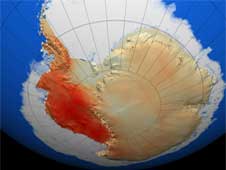West Antarctica, the part that sticks out from the continent, is warming faster than the eastern, higher part is cooling

Scientists who study climate change have long believed that while most of the Earth is gradually warming, a large part of Antarctica - the East Antarctic Ice Sheet - is actually cooling. Previous reports have shown that East Antarctica It has cooled down Since 1978, something that has brought the World Panel on Climate Change to the conclusion that Antarctica is the only continent where we have failed and failed to provide evidence that it has been affected by warming.
However, new studies show that over the past fifty years, most of the Antarctic continent has warmed at a rate similar to that of the rest of the world. In fact, the warming in West Antarctica is greater than the cooling in the east, and this means that the average on the continent is warming, says Prof. Eric Steig, from the University of Washington.
The researchers used data collected at ground stations on the Antarctic Peninsula starting in 1957 - the International Geophysical Year, but most of the findings were from the peninsula and areas at the edge of the continent itself, and high-resolution radiometer data from NASA's Goddard Space Center, which have been placed on satellites since 1981.
"West Antarctica is very different from East Antarctica, and there is a physical barrier between them - the Trans-Antarctic mountain chain, which separates them," said Steig, the lead researcher in the study published on January 22 in the journal Nature.
For years, scientists believed that a small area known as the Antarctic Peninsula is warming, but the rest of the continent, including West Antarctica, is cooling. Steig commented that the West Antarctic ice sheet is about 6,000 feet above sea level (about 2,000 meters). While the entire continent is practically a desert, West Antarctica is a relatively warm place, and it gets much more snowstorms than the east of the continent.
The study found that the warming in West Antarctica has reached a tenth of a degree Celsius per decade in the last fifty years and is more than compensating for the cooling in East Antarctica.
West Antarctica is particularly sensitive to climate change because most of the ice that covers it is below sea level and surrounded by floating ice shelves. If all the ice in West Antarctica melts, the sea level will rise by 5-6 meters. As I recall in 2005 Fell apart A large glacier in West Antarctica.

2 תגובות
Pay attention to the following article (which hypothesizes that an underwater eruption of a volcano in this area causes the melting of the glaciers to accelerate):
http://www.efluxmedia.com/news_Natural_Cause_For_West_Antarcticas_Warming_33907.html
Can someone check in depth?
I hope we survive to see the consequences of climate change